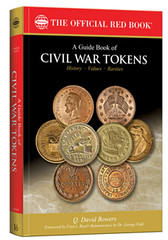
PREV ARTICLE
NEXT ARTICLE
FULL ISSUE
PREV FULL ISSUE
BOOK REVIEW: A GUIDE BOOK OF CIVIL WAR TOKENS
Steve Bishop submitted this review of Dave Bowers' new book on Civil War Tokens. Thanks!
-Editor
Years ago, I had amassed a pretty good collection of Civil War tokens, including some rare varieties and off-metals. I regret selling it (at the time I needed the money), because now, Q. David Bowers has written a well-composed and interesting book on the series, which is bound to increase the popularity (and prices) of examples of these historically fascinating bits of commerce. In brief, Civil War tokens were a consequence of the shortage of hard money during the war, in which paper money drove most circulating coinage out of circulation, silver and gold especially, but also including copper and copper-nickel. Enterprising merchants issued the cent-sized tokens as change, having bought them from suppliers at less than one cent each, thereby making a profit. If the merchant’s name was not included on the piece, they couldn’t be redeemed, but typically circulated widely. Tokens not issued as advertising pieces (store cards) generally had a patriotic theme, and while the store cards were meant as advertising, they too sometimes expressed the merchant’s patriotism. Many of the pieces imitated the size and design of the Indian cent, and some were marked “Not One Cent” to avoid charges of counterfeiting. Even so, their distribution was outlawed in 1862 under the same law that authorized use of postage stamps as money, but that ban had little effect, and more tokens were issued in 1863 than in any other year. A later law in 1864 was more effective. There are over 10,000 varieties of Civil War tokens, and this book does a pretty good job of cataloguing the dies and merchants that make them up. To be able to fully attribute all of the tokens you may encounter, you need the standard in the field, the volumes on Patriotics and Store Cards by George and Melvin Fuld, but this is a good book for both the casual and serious collector, because you can probably correctly identify most of them. For a casual collector, this book is probably enough, and for the serious collector, this is a good “take-along” book when you don’t want to lug around the several pounds of the Fuld references. There are two really great things about this book: 1) The pictures of the patriotic and store card dies are in color, which makes for a really beautiful presentation, since the pictures included are generally of very high condition pieces. 2) David Bowers is one of the best popularizers of numismatics, and is one of the few people who is both a true expert on Civil War tokens (he has an extensive collection and has studied them for years) and an excellent writer. He provides extensive historical background that is missing from many catalogs of exonumia. The historical information in this book makes it a good read for Civil War buffs, people interested in economic history, and people generally interested in numismatics. It includes a listing of the engravers and die sinkers who produced the dies, as well as an appendix that briefly covers encased postage stamps, which also circulated as small change during the War Between the States. The cost is a fraction of what you would pay for the Fuld references, and it actually makes good bedtime reading. Highly recommended.
I was planning to write a review myself, but Steve has already done such a good job I could probably say "ditto" and move on. But I will mention a few other thoughts of mine.
First, I appreciate the short appendices. One covers Encased Postage Stamps, which are closely related to CWTS. Others list tokens included in the earlier Fuld books, but now believed not to be contemporary to the Civil War. My favorite though, is Appendix I, which gives short bios of Selected Civil War Token Engravers and Coiners. On the down side, the storecard listings are extremely brief, but of course this is all such a guide book will allow; providing much more information about each token would result in a mammoth work. But the book is right on target for carrying to shows for quick reference. I do like the grid format of color images of stock reverse dies. The color photos throughout are marvelous; as Steve notes, they are of high condition specimens and many dazzle the eye. My favorite chapter (and one most bibliophiles will appreciate) is Chapter 4: Civil War Tokens and the History of Collecting Them. This could easily be expeanded to a book-length treatment someday. Included is the first known published numismatic study of the series, the Pliny E. Chase monograph published in 1863. It's a very rare item I'm proud to have in my numismatic library. Of course, the reminiscence of George Fuld is hugely important to numismatic history, and makes an apt starting point for this long-awaited book. It's certainly one I will make room for on my library shelves. -Editor Dennis Tucker of Whitman Publishing adds: Dave’s new Civil War tokens book is a runaway. We actually sold out at the Chicago ANA and had to have more boxes shipped up from our warehouse during the show!
To read the earlier E-Sylum article, see:
NEW BOOK: A GUIDE BOOK OF CIVIL WAR TOKENS
(www.coinbooks.org/esylum_v16n42a03.html)
The Numismatic Bibliomania Society is a non-profit organization promoting numismatic literature. See our web site at coinbooks.org. To submit items for publication in The E-Sylum, write to the Editor at this address: whomren@gmail.com To subscribe go to: https://my.binhost.com/lists/listinfo/esylum All Rights Reserved. NBS Home Page Contact the NBS webmaster 
|
